Normal Short Circuit Rating of Circuit Breaker
Engineers design high voltage circuit breakers to handle very high short-circuit currents. Manufacturers build these breakers to interrupt extremely high fault levels effectively. They typically rate circuit breakers for short-circuit breaking capacities such as 25kA, 31.5kA, 40kA, or even 50kA and more. Such ratings define their ability to safely interrupt fault currents of that magnitude. Engineers use high current rated circuit breakers. These breakers clear high fault currents. They protect system components from damage. This ensures electrical protection and system stability during extreme fault conditions.

Interruption of Short-Circuit Current
The circuit breaker will clear the short-circuit current. When the contacts of the main circuit breaker open, the short-circuit current continues to flow through arcing. The current waveform naturally crosses zero. At that moment, the circuit breaker tries to re-establish the dielectric medium between the contacts. It does this by deionizing the contact gap. This means the system quickly restores the dielectric strength. As a result, another arc does not form between the contacts. In this way, the circuit breaker interrupts the short-circuit current.
Interruption of Low-Level Current
Now, suppose a very low current flows through the circuit breaker. The circuit breaker needs to interrupt it. But it may not recognize that the current is low. Still, it will apply the same deionization force – i.e., the same actions to restore the dielectric medium.
Effect of Strong Deionization on Low Current
In low current conditions, the arc plasma contains far fewer electrons and ions than in a high short-circuit current. The strong deionization forces act quickly. They cause these few electrons and ions to recombine rapidly. As a result, the system re-establishes the dielectric strength even before the current reaches its natural zero. Since the dielectric strength builds up so fast in the contact gap, the circuit breaker may interrupt the current early. This may lead to an abrupt interruption or chopping of the current. This is what we call current chopping.
Current Chopping and Its Consequences
Current chopping means the sudden change of current with respect to time. As we’ve already said, the circuit is highly inductive, but the current is low. So, \(L\frac{di}{dt}\) becomes very high. As a result of this high \(L\frac{di}{dt}\), a very high restriking voltage appears.
Restriking of the Arc
Now, if this restriking voltage is high enough, the arc may re-establish, and the current may start flowing again due to the high restriking voltage. Yes, the medium becomes re-ionized again due to the high voltage gradient caused by high \(L\frac{di}{dt}\), and the arc reappears.
Cycle of Re-Striking and Chopping
Once the arc reappears, the current starts flowing again. This time, the current may be even higher than before. The restriking voltage has increased, causing this rise. The circuit breaker again applies a strong deionization force. It chops the current once more. This chopping produces a higher \(L\frac{di}{dt}\). As a result, the restriking voltage becomes even greater than before.
Final Interruption of Current
In this way, with every restrike, the restriking voltage keeps increasing. This cycle continues, and ultimately the current may or may not be interrupted properly. Meanwhile, the contact gap is slowly increasing since the moving contact is gradually separating from the fixed contact. So, with every restrike, the gap becomes larger, and the required deionization force also increases accordingly. After a certain gap, the dielectric strength between the gap becomes so strong no more restrikes will occur, and the current will finally be completely interrupted.
